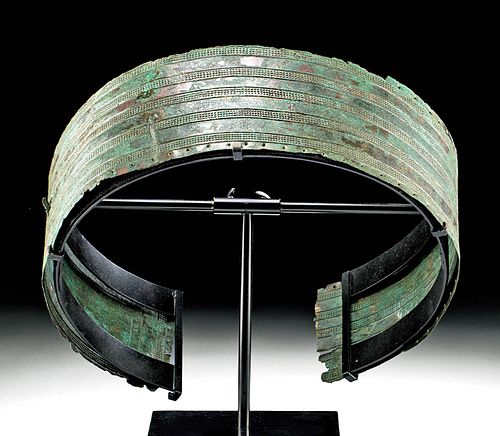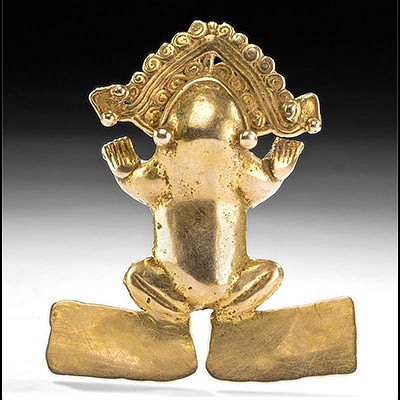Urartian Bronze Belt - Beautiful Geometric Decoration
Lot 46
About Seller
Artemis Fine Arts
686 S Taylor Ave, Ste 106
Louisville, CO 80027
United States
Selling antiquities, ancient and ethnographic art online since 1993, Artemis Gallery specializes in Classical Antiquities (Egyptian, Greek, Roman, Near Eastern), Asian, Pre-Columbian, African / Tribal / Oceanographic art. Our extensive inventory includes pottery, stone, metal, wood, glass and textil...Read more
Categories
Estimate:
$5,000 - $7,000
Absentee vs Live bid
Two ways to bid:
- Leave a max absentee bid and the platform will bid on your behalf up to your maximum bid during the live auction.
- Bid live during the auction and your bids will be submitted real-time to the auctioneer.
Bid Increments
| Price | Bid Increment |
|---|---|
| $0 | $25 |
| $300 | $50 |
| $1,000 | $100 |
| $2,000 | $250 |
| $5,000 | $500 |
| $10,000 | $1,000 |
| $20,000 | $2,500 |
| $50,000 | $5,000 |
| $100,000 | $10,000 |
| $200,000 | $20,000 |
About Auction
By Artemis Fine Arts
Aug 13, 2020
Set Reminder
2020-08-13 10:00:00
2020-08-13 10:00:00
America/New_York
Bidsquare
Bidsquare : Fine Antiquities, Ethnographic & Fine Art
https://www.bidsquare.com/auctions/artemis-gallery/fine-antiquities-ethnographic-fine-art-5415
Features classical antiquities, ancient and ethnographic art from cultures encompassing the globe. Egyptian, Greek, Roman, Etruscan, Near Eastern, Asian, Pre-Columbian, Native American, African / Tribal, Oceanic, Spanish Colonial, Russian, Fine Art, so much more! Artemis Fine Arts info@artemisfinearts.com
Features classical antiquities, ancient and ethnographic art from cultures encompassing the globe. Egyptian, Greek, Roman, Etruscan, Near Eastern, Asian, Pre-Columbian, Native American, African / Tribal, Oceanic, Spanish Colonial, Russian, Fine Art, so much more! Artemis Fine Arts info@artemisfinearts.com
- Lot Description
Caucasus region, modern day eastern Turkey (Anatolia)/Armenia, Urartu culture, ca. 9th to 7th century BCE. A rare, near-complete Urartian belt made from hammered bronze and decorated in chased low relief/repousse geometric motifs. These form a series of lightly raised bands around the edges and in the center that curve at right angles at the terminals, forming a labyrinth-like motif on the whole. Tiny perforations along one long edge give an idea of how it would have been worn - probably sewn onto a leather or other fabric-like backing. Urartian warriors and other elites wore elaborate bronze belts as a display of their important status in society. Size: 33.75" W x 3.95" H (85.7 cm x 10 cm); 12.25" H (31.1 cm) on included custom stand.
Urartu had such skill with bronze work that the Assyrians would take their finished metal objects whenever they could, through trade, warfare, or plunder. For example, Assyrian king Sargon II listed 305,000 bronze daggers as the plunder from a successful campaign in Urartu. The unmistakable artistry of this piece reminds us why Sargon II stole them!
Provenance: private East Coast, USA collection; ex-Esmerian collection, New York, USA, 1980s
All items legal to buy/sell under U.S. Statute covering cultural patrimony Code 2600, CHAPTER 14, and are guaranteed to be as described or your money back.
A Certificate of Authenticity will accompany all winning bids.
We ship worldwide and handle all shipping in-house for your convenience.
#154304Losses from the peripheries, notably much of the upper edge and one of the terminals. A few small tears in the surface and one area of repair along the lower edge. This repair is well done and difficult to see. Great mottled green, red, and turquoise patina with flashes of the original bronze coloration visible underneath.Condition
- Shipping Info
-
All shipping is handled in-house for your convenience. Your invoice from Artemis Gallery will include shipping calculation instructions. If in doubt, please inquire BEFORE bidding for estimated shipping costs for individual items.
-
- Buyer's Premium



 EUR
EUR CAD
CAD AUD
AUD GBP
GBP MXN
MXN HKD
HKD CNY
CNY MYR
MYR SEK
SEK SGD
SGD CHF
CHF THB
THB














